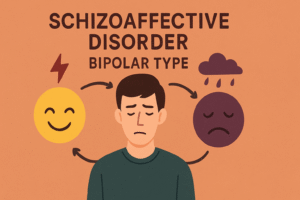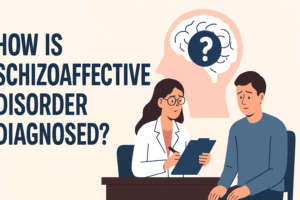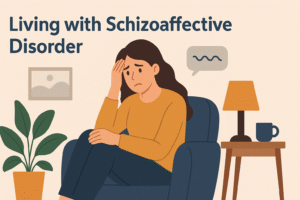Mental health conditions are often misunderstood, and one of the most complex among them is schizoaffective disorder. This psychiatric condition lies at the intersection of schizophrenia and mood disorders, making it both unique and challenging to diagnose. People living with schizoaffective disorder often experience a blend of psychotic symptoms such as hallucinations and delusions, along with significant mood disturbances—either depressive episodes or a combination of manic and depressive episodes. Schizoaffective Disorder (BIPOLAR Type vs Depressive Type)
Understanding the two main subtypes of schizoaffective disorder—bipolar type and depressive type—is crucial not only for patients and their families but also for mental health professionals. Each subtype presents differently, responds differently to treatments, and can impact daily life in distinct ways. Top 10 Mental Health Awareness Activities for Work
Will take you through everything you need to know about schizoaffective disorder, breaking down its types, symptoms, treatments, and coping strategies. Whether you’re researching for personal reasons, supporting a loved one, or seeking reliable information, this resource aims to provide a clear, compassionate, and detailed perspective.
What is Schizoaffective Disorder?
Schizoaffective disorder is a chronic mental health condition characterized by a combination of symptoms from two distinct categories:
Schizophrenia symptoms – such as hallucinations, delusions, and disorganized thinking.
Mood disorder symptoms – such as depression or mania.
Unlike schizophrenia, which primarily involves psychotic symptoms, schizoaffective disorder always includes a mood component. And unlike pure mood disorders (such as bipolar disorder or major depressive disorder), schizoaffective disorder includes periods of psychosis that occur independently of mood episodes.
This dual nature makes the condition particularly complex. Some researchers view schizoaffective disorder as sitting on a spectrum between schizophrenia and mood disorders rather than being a completely separate illness. Regardless, it is a distinct diagnosis recognized in the Diagnostic and Statistical Manual of Mental Disorders, Fifth Edition (DSM-5).
Types of Schizoaffective Disorder
According to the DSM-5, there are two primary subtypes of schizoaffective disorder:
Bipolar Type – This involves episodes of mania and depression alongside psychotic symptoms.
Depressive Type – This involves major depressive episodes alongside psychotic symptoms but no manic episodes.
Both subtypes share core psychotic features, but their mood-related symptoms differ significantly, shaping how they are diagnosed, treated, and managed.
Schizoaffective Disorder – Bipolar Type
The bipolar type of schizoaffective disorder is defined by the presence of psychotic symptoms occurring alongside mood episodes characteristic of bipolar disorder. This means that patients experience both manic episodes and sometimes depressive episodes, in addition to symptoms of schizophrenia.
Manic Episodes
During mania, individuals may:
Feel euphoric or unusually irritable.
Have racing thoughts and rapid speech.
Exhibit increased energy and decreased need for sleep.
Engage in impulsive or risky behaviors, such as overspending, reckless driving, or unsafe sexual activity.
Show inflated self-esteem or grandiosity.
Mania can be exciting at first, but it often leads to dangerous outcomes due to impaired judgment.
Depressive Episodes in Bipolar Type
The depressive phases resemble those in major depressive disorder, including:
Feelings of sadness or hopelessness.
Loss of interest in previously enjoyable activities.
Fatigue and difficulty concentrating.
Changes in appetite and sleep patterns.
Suicidal thoughts or behaviors in severe cases.
Psychotic Symptoms in Bipolar Type
Psychotic features may occur during mood episodes or persist outside of them. Common symptoms include:
Hallucinations (hearing voices, seeing things others don’t).
Delusions (false beliefs, such as thinking one has special powers or that others are plotting harm).
Disorganized speech and thought patterns.
The coexistence of manic highs, depressive lows, and psychotic features makes this subtype especially challenging. Patients may swing between extremes, making stabilization a key goal of treatment.

Schizoaffective Disorder – Depressive Type
The depressive type of schizoaffective disorder involves major depressive episodes alongside psychotic symptoms, but no manic episodes.
Depressive Symptoms
Persistent sadness, emptiness, or hopelessness.
Withdrawal from friends and family.
Loss of motivation and pleasure in life.
Poor concentration, fatigue, and slowed thinking.
Physical symptoms such as headaches, digestive issues, or chronic pain.
Suicidal ideation or self-harm tendencies.
Psychotic Symptoms in Depressive Type
Like the bipolar type, patients may experience hallucinations and delusions, though these often have a depressive theme (e.g., hearing a voice reinforcing feelings of worthlessness).
Impact on Daily Life
This type can be particularly debilitating because both psychosis and depression significantly impair daily functioning. Unlike the bipolar type, there are no periods of mania that provide temporary bursts of energy or confidence.
Key Differences: Bipolar vs Depressive Type
Although both types share psychotic features, the mood symptoms differ:
| Feature | Bipolar Type | Depressive Type |
| Mood Episodes | Manic + Depressive | Depressive only |
| Energy Levels | Alternating high energy (mania) and low (depression) | Consistently low energy, sadness, hopelessness |
| Risk Factors | Impulsivity, risky behavior during mania | Severe fatigue, suicidal tendencies |
| Diagnosis Challenges | Confusion with bipolar disorder with/ psychotic features | Confusion with major depressive disorder with/ psychotic features |
| Treatment Focus | Balancing mood stabilization + psychosis | Relieving depression + psychosis |
How is Schizoaffective Disorder Diagnosed?
Diagnosis requires careful evaluation because symptoms overlap with other conditions. A psychiatrist typically:
Conducts a comprehensive psychiatric evaluation.
Reviews personal and family medical history.
Uses DSM-5 criteria, which require:
A major mood episode (depressive or manic) concurrent with schizophrenia symptoms.
Psychotic symptoms persisting for at least two weeks without mood symptoms.
Symptoms not explained by substance use or another medical condition.
The process often takes time and multiple consultations because symptoms may shift over months or years.

Treatment Options for Schizoaffective Disorder
Treatment must address both the psychotic and mood-related symptoms, making it multifaceted.
Medications
Antipsychotics: Reduce hallucinations and delusions. (e.g., risperidone, paliperidone).
Mood stabilizers: Help manage manic and depressive swings in bipolar type. (e.g., lithium, valproate).
Antidepressants: Address depressive symptoms, especially in depressive type.
Therapies
Cognitive Behavioral Therapy (CBT): Helps challenge distorted thinking.
Family Therapy: Improves communication and reduces caregiver stress.
Supportive Counseling: Provides coping strategies and emotional support.
Lifestyle and Self-Care
Maintaining regular sleep and meal schedules.
Avoiding drugs and alcohol.
Practicing stress-reduction techniques (yoga, meditation, journaling).
Building strong support networks.
Treatment is often lifelong, with adjustments as symptoms evolve.
Living with Schizoaffective Disorder
Life with schizoaffective disorder is challenging but not hopeless. Many people live fulfilling lives with proper treatment.
Daily Challenges: Managing medication side effects, coping with stigma, and balancing work and relationships.
Coping Skills: Journaling moods, practicing mindfulness, and adhering to medical appointments.
Support Systems: Peer groups, therapists, and family support can help reduce feelings of isolation.
Resilience and Recovery: With treatment, many achieve long-term stability and independence.
Support and Resources
Getting help is vital. Useful resources include:
National Alliance on Mental Illness (NAMI) – nami.org
Schizophrenia & Psychosis Action Alliance – sczaction.org
Mental Health America (MHA) – mhanational.org
Local hospitals, community clinics, and online support forums.
For emergencies, always call local crisis hotlines or 988 (U.S. Suicide & Crisis Lifeline). World Health Organization – Mental Health

Conclusion
Schizoaffective disorder is a complex but manageable mental health condition. By understanding the differences between bipolar type and depressive type, patients, families, and clinicians can make more informed choices about treatment and support. While challenges exist, recovery and stability are possible with the right approach.
If you or someone you know is struggling with schizoaffective disorder, remember—you are not alone, and professional help is available.
FAQs
- Can schizoaffective disorder go away?
No, it is a lifelong condition, but with treatment, symptoms can be managed, and many people live fulfilling lives. - How is schizoaffective disorder different from schizophrenia and bipolar disorder?
Schizoaffective disorder combines symptoms of both, while schizophrenia involves psychosis alone, and bipolar disorder involves mood swings without persistent psychosis. - Can someone with schizoaffective disorder live a normal life?
Yes. With consistent treatment and support, many individuals work, maintain relationships, and enjoy meaningful lives. - Which is more severe, the bipolar type or the depressive type?
Severity varies per individual. Bipolar type may involve more impulsivity, while depressive type often carries a higher suicide risk. - What are the best coping strategies for schizoaffective disorder?
Medication adherence, therapy, lifestyle routines, and strong support networks are essential coping strategies.

